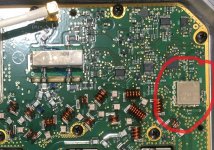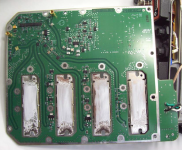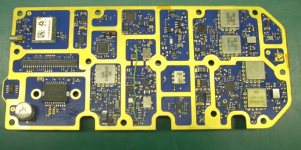I have a XG-100M I bought a few months back and did not immediately test. Dumb move on my part. It turns out the radio programmed fine but it had no transmit power out and no receive sensitivity. It was as if there was a big attenuator in the middle of the antenna path. I figured I would concentrate on that area first.
Today I finally cracked it open and was lucky enough to quickly find the problem.
This is a picture of the RF board that has the four RF amplifier modules from Mitsubishi. From right to left they cover in MHz: 136-174, 378-470, 440-529, 763-870. There are sets of pin diodes (white SMD blocks with a black polarity dot) used to steer their outputs back towards the antenna. Note the circuitry in the red circle. This is where the antenna connection is steered to the power amps or the receiver.
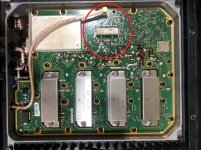
This is a sketch of what I think the basic antenna input circuit entails.
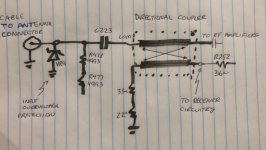
Here is a bit of a closer shot of that circuitry with labels on the coupler's ports. The coupler appears to be two short lengths
of rigid copper coax, each feeding through a toroid with windings. You can just see the blue wires around the toroids in the last picture below.
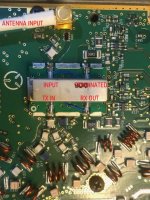
Long story short, the TX and RX ports and C378 had little to no solder
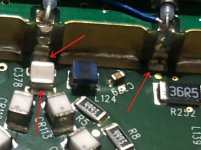
I resoldered each spot and transmit power and sensitivity are restored.
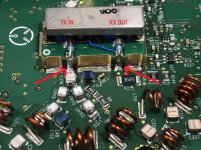
In a future post I will theorize about what I think the overall block diagram and functionality of the radio are.
Today I finally cracked it open and was lucky enough to quickly find the problem.
This is a picture of the RF board that has the four RF amplifier modules from Mitsubishi. From right to left they cover in MHz: 136-174, 378-470, 440-529, 763-870. There are sets of pin diodes (white SMD blocks with a black polarity dot) used to steer their outputs back towards the antenna. Note the circuitry in the red circle. This is where the antenna connection is steered to the power amps or the receiver.

This is a sketch of what I think the basic antenna input circuit entails.

Here is a bit of a closer shot of that circuitry with labels on the coupler's ports. The coupler appears to be two short lengths
of rigid copper coax, each feeding through a toroid with windings. You can just see the blue wires around the toroids in the last picture below.

Long story short, the TX and RX ports and C378 had little to no solder

I resoldered each spot and transmit power and sensitivity are restored.

In a future post I will theorize about what I think the overall block diagram and functionality of the radio are.


